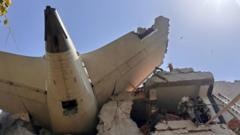Flight AI171, which crashed shortly after takeoff from Ahmedabad, raises questions over potential mechanical failures or human error.
**Investigation Underway After Devastating Air India Flight AI171 Crash**

**Investigation Underway After Devastating Air India Flight AI171 Crash**
Experts from India, the US, and the UK to probe causes behind crash shortly after takeoff.
In a tragic turn of events, Air India Flight AI171 crashed just 30 seconds after taking off from Ahmedabad's Sardar Vallabhbhai Patel International Airport, resulting in the loss of 241 lives on board and several casualties on the ground. Preliminary investigations are set to be conducted by Indian officials alongside experts from the US and UK, focusing on what appears to be a complex series of failures during a critical period of flight. This incident marks a historical first, as it is the Boeing 787-8 Dreamliner’s first fatal crash since its operational debut in 2011.
The aircraft had a full cargo of approximately 100 tonnes of fuel, complicating the situation immediately after launch. Eyewitness reports describe an ominous mayday call from the cockpit, which was followed by an alarming descent towards residential terrain, resulting in catastrophic structural damage to nearby buildings.
A contributing factor suggested by aviation experts is the aircraft's struggle for altitude, which may point to potential technical failures, such as a rare double engine failure or fuel system issues. Considering the flight's altitude peaked at only 625 feet during its brief airborne time, speculation about engine failure is underscored by accounts describing a loud explosion prior to the crash.
The dual-engine failure theory, although previously unprecedented, raises concerns about fuel micromanagement or possible contamination. Other possibilities include a bird strike, particularly given Ahmedabad’s high incidence of avian strikes—462 reported cases over the last five years.
Flap configuration during takeoff has also emerged as a point of contention, sparking debate over whether improper flap settings contributed to the accident. Adequate flap extension is critical for a loaded aircraft to generate lift during takeoff phases, especially in challenging environmental conditions such as the recent high temperatures experienced in Ahmedabad. However, the take-off Configuration Warning System integrated into the 787 may have prevented human error if crew protocols were followed correctly.
As investigations progress, collecting data from the aircraft’s black box and analyzing debris will be vital in uncovering the exact trigger of this devastating incident. The aviation industry will be closely watching developments in this investigation as potential precursors to tragic accidents are examined.




















